 US Military Vehicles Normandy 1944. Pauleian.
US Military Vehicles Normandy 1944. Pauleian.
During the Battle of Normandy, the US Army used a striking array of different vehicles for various purposes, from motorcycles to tanks. Many of them survived the war to either continue service within different armies or to become the pride of their civilian owners. Several have been preserved, to be offered a new lease of life thanks to enthusiastic collectors who regularly revive them during commemorative events. Others have regrettably been less fortunate - hence this US army depository following the ruthless battles of 1944 (see photo below).
This guide offers you an introduction to the many vehicles used by the Americans during the Battle of Normandy, illustrated by a number of hitherto unpublished photographs, from jeeps to Sherman tanks, not forgetting trucks and other specialised heavy vehicles.
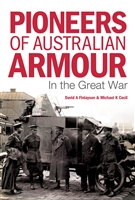 Pioneers of Australian Armour In the Great War. Finlayson, Cecil,
Pioneers of Australian Armour In the Great War. Finlayson, Cecil,
Pioneers of Australian Armour tells the story of the only Australian mechanised units of the Great War. The 1st Australian Armoured Car Section, later the 1st Australian Light Car Patrol, and the Special Tank Section were among the trailblazers of mechanisation and represented the cutting edge of technology on the Great War battlefield.
The 1st Armoured Car Section was raised in Melbourne in 1916, the brainchild of a group of enthusiasts who financed, designed and then built two armoured cars. Having persuaded the Australian Army of the vehicles’ utility in the desert campaign, the Armoured Car Section, later re-equipped with Model T Fords and retitled the 1st Australian Light Car Patrol, provided valuable service until well after the Armistice.
The First World War also saw the emergence of the tank which, despite unpromising beginnings, was to realise its potential in the crucial 1918 battles of Hamel and Amiens. A British Mark IV tank which toured Australia in 1918 demonstrated the power of this new weapon to an awestruck Australian public.
Much of the story of the armoured cars is told in the voices of the original members of the section and in newspaper articles of the time which highlight the novelty of these vehicles. Painstaking research has produced a remarkable collection of images to accompany the narrative, many never previously published. Biographies of the members of these extraordinary units are also a feature of this book, their stories told from the cradle to the grave. Appendixes provide a wealth of supporting biographical and technical information that enriches the text and adds factual detail.
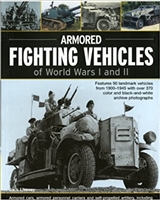 Armoured Fighting Vehicles of World Wars 1 and 2. Livesey.
Armoured Fighting Vehicles of World Wars 1 and 2. Livesey.
In 1900 a British motoring enthusiast, F. R. Simms, had the idea of mounting a machine-gun on the front of a quadricycle and installing a small petrol engine at the rear. His machine spurred on others to design similar "war cars", and the armoured fighting vehicle (AFV) was born. This book is the story of subsequent developments, and starts with an authoritative history of all types of AFV from from 1900-1945, covering a wide range of wheeled, tracked and semi-tracked vehicles. From the days before radio communication through to the end of World War II, the author highlights the varied roles AFV's have played, as well as how these adaptable vehicles have evolved and developed over time.
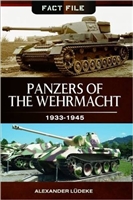 Panzers of the Wehrmacht. 1933 - 1945. Ludeke
Panzers of the Wehrmacht. 1933 - 1945. Ludeke
German Panzers continue to exert a tremendous fascination for military historians and military vehicle enthusiasts alike. To the delight of all fans of tank warfare, this Fact File provides valuable reference on vehicles of the German Wehrmacht. During the Second World War the tank became the main weapon of every army. This Fact File edition provides a concise technical history of German WW2 tanks.
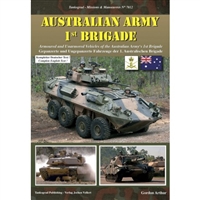 Australian Army - 1st Brigade. Arthur
Australian Army - 1st Brigade. Arthur
The Australian 1st Division has three brigades, with the 1st Brigade acting as the army's major mechanised formation equipped with M113s, ASLAVs and the new M1A1 AIM Abrams main battle tanks. This publication grants an inside on the unusual motor pool of this unit and its regiments in hitherto unpublished photographs.
 The Jeep in Detail. Koran, Mostek.
The Jeep in Detail. Koran, Mostek.
Jeep In Detail: M38A1 & M606A2, The First from the New Military Jeep Generation is billed as a photo manual for modelers, but restorers will find the pictures very helpful. Covers the M38A1 and the M606A2.
Good addition to any collection
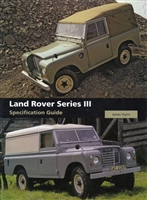 Land Rover Series III Specification Guide. Taylor.
Land Rover Series III Specification Guide. Taylor.
With around 400 illustrations, this is the most wide-ranging book yet written on the Series III Land Rovers, and is certain to become the standard reference guide for restorers and enthusiasts.
The complete specification guide to Series III Land Rovers, produced from 1971 to 1985 covers:
Vehicle identification and specification changes
Options on standard models and special equipment
Conversions and Forward Control models
Overseas models and markets
Military and Lightweight models
The Series III Land Rovers enjoyed a long production run of nearly fifteen years, taking over from the Series IIA types in 1971. They overlapped with the new coil-sprung models in their last two years between 1983 and 1985, and were the last leaf-sprung Land Rovers. They stood at a crossroads in the marque's history because, in Stage 1 V8 form from 1979, they embraced the new technology of permanent four-wheel drive, which would become a Land Rover trademark.
Precise production figures are still in doubt, but were close on the half-million mark. That number embraced a huge variety of different specifications, and enthusiasts today often have difficulty in discovering what their vehicles would have been like when they were new. Many Series Ills have been modified in service over the years, which means that there are few completely original vehicles around to use as reference guides.
This book follows its predecessor, Land Rover Series II and IIA Specification Guide, in trying to establish exactly how its subject vehicles would have been when they were new. Compiled over a period of more than thirty years, the book draws on extensive reference material from Land Rover itself, and on the observations and knowledge of an army of enthusiasts. It will function as a comprehensive reference guide to the specifications of the various Series ill Land Rovers, and also to the dozens of options, items of special equipment and major conversions. In addition, it covers military versions of the civilian Series Ills, the military-only Lightweight or Half-Ton model, and the special models built for overseas markets and in overseas countries.
 For Want of a Gun. The Sherman Tank Scandal of WW 11. Dejohn.
For Want of a Gun. The Sherman Tank Scandal of WW 11. Dejohn.
This remarkable story exposes the Sherman tank scandal of World War II, involving some of the biggest American names and stretching from the White House and Pentagon to factories and battlefronts. Outgunned by more powerful German opponents, the inferiority of American tanks led to some of the worst setbacks of the war, prolonging it in Europe. US tankers ultimately prevailed, but over 60,000 armored division soldiers were killed and wounded; their preventable sacrifice inspired the Hollywood movie Fury. Included are striking images of the Sherman’s adversaries (photographed exclusively at the National Museum of Cavalry and Armour), along with original equipment, documents, period propaganda, and vintage photos of Sherman tanks in action. As a German officer noted, “I was on this hill with six 88 mm antitank guns…Every time they sent a tank, we knocked it out. Finally we ran out of ammunition, and the Americans didn’t run out of tanks.”
